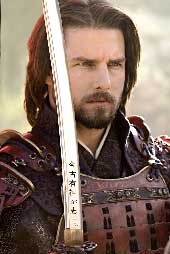 |
| Tom Cruise in The Last Samurai |
 |
| Uma Thurman in Kill Bill |
Tokyo, Feb. 22 (Reuters): With Tom Cruise acting the warrior in The Last Samurai, and Uma Thurman set to slice her way to revenge in part two of the action movie Kill Bill this spring, Japanese swordsmanship is cutting a dash in Hollywood.
Two samurai-themed films have even picked up nominations for the Oscars at the end of this month. But practitioners of Iaido (pronounced ee-eye-doh), a 500-year-old Japanese martial art performed with real swords, say it has more in common with zen meditation than with the spectacular rough and tumble of cinema stunts.
“They are very good at choreographing fights to make them fun to watch,” said Sadanori Ueno, a 77-year-old retired engineer and one of Japan’s highest rated Iaidoka, or swordsmen, when asked about films like The Last Samurai and Twilight Samurai. “But what we do is entirely different.”
Far from the clatter of a movie battle scene, the shuffling of bare feet on the wooden floor and the swish of steel blades were often the only sounds during a practice session Ueno recently held in Utsunomiya, 100 km north of Tokyo.
Though their skills are based on the lethal techniques of samurai who earned their living by the sword in feudal times, the only blood these modern-day Iaidoka are likely to shed is their own, as they generally perform solo.
Like many Iaido practitioners, Ueno took up kendo, the related martial art of fighting with wooden swords, as a boy. He had to give it up after World War Two when it was banned under the six-year US occupation of Japan.
He later switched to Iaido, working his way up through written and practical tests of increasing difficulty required to become one of the few to pass the top level, or eighth“dan.”
Dressed in practice gear consisting of a kimono-like garment and full trousers with a tightly fastened sash, the students kneel and bow to a shrine on one wall of the dojo, or martial arts hall, at the start of the class.
They then run through a series of dozens of set moves, sometimes lightning-fast, but each ending with the sword being slowly replaced in its scabbard.
Each manoeuvre has its own scenario — dispatching three opponents at once, or ducking down to deal with a rival hiding under a piece of furniture.
About 9 per cent of Iaido practitioners are women — not an entirely new development in Japan, where samurai wives were often trained to protect themselves with a short sword.











